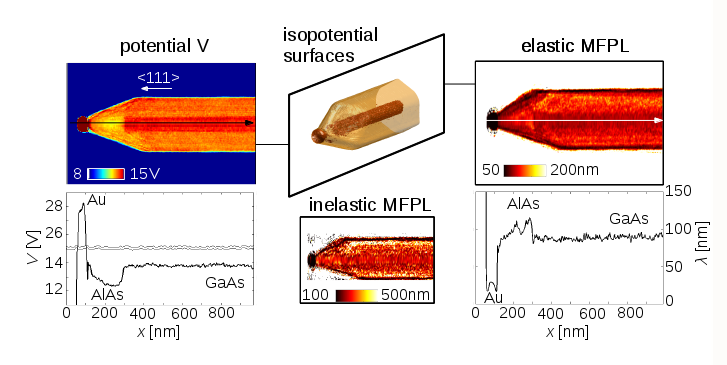IT-11-O-1905 Electron Holographic Tomography of Mean Free Path Lengths with nm-Resolution
In off-axis Electron Holography a Möllenstedt biprism is introduced slightly above an intermediate image plane (image coordinates R) in the TEM to generate an interference pattern (“hologram”) with the following sinusoidal intensity distribution Ihol(R) = I0+I(R)+2μA0A(R)cos(QR+φ(R)). Here, I0, I, μ, A0, A, Q and φ are the reference intensity, conventional image intensity, contrast damping factor due to camera MTF and partial coherence, reference amplitude, reconstructed amplitude, carrier frequency and reconstructed phase. Reconstructed phases have been successfully analyzed in terms of various electrostatic and magnetostatic potential characteristics. In this contribution we will show how to tomographically reconstruct elastic and inelastic mean free path lengths (MFPL) from the concomitantly reconstructed conventional image intensity I and amplitude A. Starting points are the following exponential attenuation laws ln(A(R)/A0) = 0.5∫1/λA(r)dz and ln(I(R)/I0) = ∫1/λI(r)dz with corresponding attenuation coefficients λ-1 holding under out-of-zone axis conditions employed in medium resolution Electron Holography. Based on fundamental electron scattering principles we relate the λs to elastic and inelastic MFPLs correcting a serious misinterpretation preventing quantitative analysis in the past. Noting that the attenuation laws represent a Radon transformation when performed over a π-range of tilt angles, we then develop adapted tomographic reconstruction schemes. That involves dedicated normalization and regularization in order to reduce the influence of the generally low SNR. We demonstrate the MFPL reconstruction at a GaAs-Al1/3Ga2/3As core shell nanowire grown by low pressure metal-organic vapor phase epitaxy (MOVPE) method using colloidal Au nanoparticles (NPs) as metal catalysts. The tilt series was recorded at a Cs-corrected FEI TITAN TEM at 300 kV. Amongst other features its reconstructed potential reveals the core-shell structure as well a potential slope of yet unknown origin towards the Au tip (Fig. 1). The reconstructed elastic MFPL data (Fig. 1) also reveals the core-shell structure as well as a chemical composition variation from AlAs to GaAs in the tapered region thereby facilitating an unambiguous interpretation of the above noted potential slope in terms of chemical composition change. The inelastic MFPL (Fig. 1) on the other hand only vaguely hinds the existence of the core-shell which is a result of the strong delocalization of the dominating bulk plasmon excitation in the inelastic MFPL. Both elastic and inelastic MFPL agree very well with theoretic predictions.
We thank N. Lovergine (University of Salento, Lecce) for providing the GaAs/AlGaAs nanowire and T. Niermann for helping with recording the tilt series. The authors acknowledge financial support from the European Union under the Seventh Framework Program under a contract for an Integrated Infrastructure Initiative. Reference 312483 - ESTEEM2.
